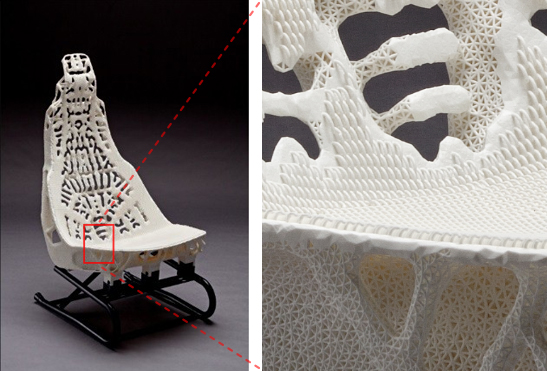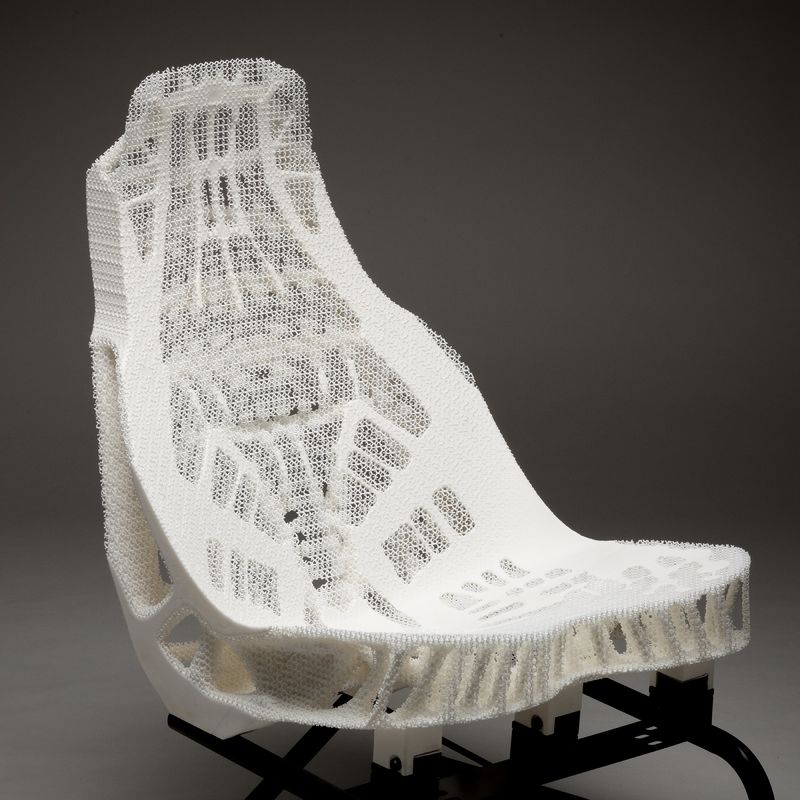Challenge
Successfully 3D print a lightweight car seat
Solution
Slice-based technology
Software used
Materialise Build Processor
Insight/how
Work with a file size of 36 MB, instead of 250 GB
Industry
Automotive
A Bionic Design

To obtain a lightweight car seat prototype, Dr. Atsushi Kawamoto, Senior Researcher at Toyota Central R&D Labs Inc., used a special type of topology optimization. By assigning material density to specific regions, the design was divided into high- and low-density areas. Toyota’s topology data was then represented by gray value images that could be read by Mimics and transformed into a 3D model.
To populate the low-density areas, Materialise developed a new unit cell in Materialise 3-matic specifically for this project. The low-density areas increased user comfort by allowing the heat of the car seat to dissipate. In addition to the creation of a new unit structure, Materialise 3-matic was used to remove dangling edges of the unit cells and to improve the comfort of the seat by adding a surface pattern of elastic beams.
The Materialise Build Processor Slice Technology Made It Happen
Needless to say, Toyota’s lightweight design filled with unit cells and a surface pattern was very hard to handle. It is nearly impossible to adapt, store and transfer the numerous triangles in STL. Therefore, Materialise developed a technology that makes it possible to easily work with complex, big data: the slice-based operations technology! The secret? The slice-based operations apply the 3D geometry at the slice level instead of at the STL level, and save all information about structures and textures as metadata.
The Materialise Build Processor’s slice-based technology was simply the only way to keep the files light, by postponing the calculations of the full design until the slicing step. The estimated STL file size was 250 GB, while the file size of the metadata was only 36 MB. Without slice-based operations and the Materialise Build Processor technology, the production of Toyota’s car seat prototype would have been impossible. The Materialise Build Processor also communicated the build order to the printer, and the car seat was then laser sintered at Materialise.
Pushing Design to the Limits
The final result was that Toyota’s car seat volume could be reduced by 72%, which corresponds to a weight reduction from 25kg to 7kg. Besides, the heat capacity was reduced from 35.4 to 14.5J/K. The challenging project led to new features in Materialise’s software and the complex, large file could be handled without problems, thanks to the slice-based operations technology of the Materialise Build Processor. In future, Toyota Central R&D Labs Inc. will apply topology optimization and Additive Manufacturing for realizing new types of functional devices.
Do you think 3D printing software could improve your business, but you don’t know what option fits your business best? Our company is built on a great passion for 3D printing software. Let’s have a talk and see how we can render your business more efficient.
All images courtesy of Toyota Central R&D Labs Inc.

